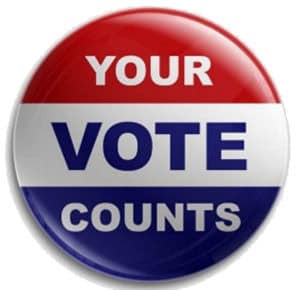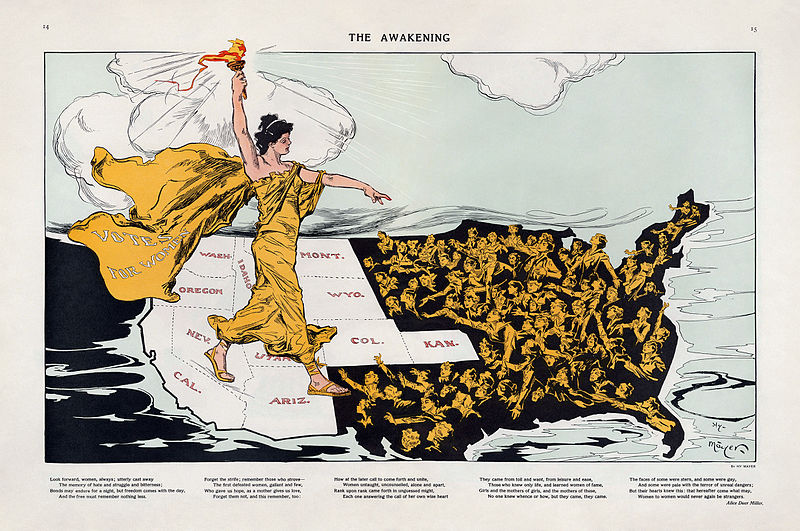
Take Political Action for Science
Quickguide
Use this Quickguide for easy access to the information and resources you need to vote. In the first section you will learn exactly how to vote. The rest of the article will prepare you to vote with the very least you need to know about elections. If you want more information and influence, check out “Take Political Action for Science.” Let’s tell our representatives how important science is to the wellbeing of our country.
Contents:
- How to Vote
- Ideals and Policies
- Political Parties
- Municipal Politics
- County Politics
- State Politics
- Congressional Politics
- Presidential Politics
- Make Contact
How to Vote
State government determines voting registration rules[1] and voting procedures.[2] Specifics available to the voter, like times and locations, are decided by the county auditor, who oversees elections. There are in general three ways to vote.
- Voting by mail prior to election day.
- Early voting in person at select times and locations.
- Voting in person on election day at the polling place determined by the location of your home residence.
Early voting is available in thirty-seven states to any qualified voter.[3] The thirteen other states require a valid excuse for needing to vote before the polls open, which is not technically early voting, but is called in-person absentee voting, and is done by absentee ballot. Depending on the state, early voting may begin anywhere from forty-five to four days before the election, or about twenty days on average.[4]
Absentee ballots allow voters to mail in their vote.[5] Registered voters may request to vote absentee and the state will send them a ballot by mail. Twenty states require an excuse. Dates ballots may be mailed out differ by state. Oregon, Washington and Colorado mail ballots to all registered voters and no longer use in-person voting precincts.
The absentee ballot may be the only option available for military and overseas voters.[6] Anyone can vote by mail. Voters may choose to use an absentee ballot if they are ill, disabled, elderly, or if they have young children or work schedules that interfere with voting at the polls. Voters may choose this option if they wish to avoid lines, extended wait times or other unavoidable factors of voting on election day.
Early voting is the best option to absolutely ensure that one will be able to vote. Voting by mail is the next best method if and only if one is sure to return the ballot in time to meet the deadline. Missing or late ballots have been a significant problem in the past.[7] Give yourself a wide berth, especially if you are voting by mail with an absentee ballot, so be sure to check your state’s registration form for the deadline.
You can vote by mail by picking up the proper paperwork from the voting assistance officer at a U.S. embassy or consulate or you can just do it from home online. Go to the Federal Voting Assistance Program’s website and choose your state of residence from the drop-down menu.
This page will provide links to your state absentee voting guidelines, state election website and your local election officials. Register to vote and request your ballot by filling out the Federal Post Card Application (FPCA) or the Federal Write-In Ballot (FWAB). You can also check the status of your ballot from a link on this page.

How to Vote (Continued)
The FWAB is the emergency backup ballot for military and overseas citizens and must be filed if one has not received one’s ballot thirty days before the election. You can usually request your ballot to be received via mail, email or fax. Check your state’s page on the FVAP website for details.
The FPCA should be completed, signed and returned to your local election official in your state of voting residence, usually the county auditor. You must submit a newly completed FPCA each year to vote in U.S. elections, which may be done at the beginning of the calendar year or within forty-five days of an election.
Your name will be added to a list to receive absentee ballots for elections held in your state during the calendar year. Depending on your state, the ballots may include all elections or just federal elections. These are normally sent off about 30 days prior to any primary, special or run-off election and forty-five days before November general elections.
Some states allow ballots to be returned via internet form, email or fax. Check your state’s page on the FPCA website for your options. If you have opted for a physical ballot, once you have received and completed it, you have a couple of options. Ballots may be mailed at your own expense by an express courier service like FedEx, UPS or DHL.
You may also drop off your ballot at a U.S. embassy or consulate to be mailed via their Diplomatic Pouch. You will need enough time to coordinate with the local post office for an envelope addressed to your local election officials with appropriate U.S. postage or buy an envelope and print your own postage-paid return envelope downloadable on the FPCA website. Visit the embassy’s website or ask a voting assistance officer for full instructions.
If you are voting in person, find your polling station HERE.
Make sure that you bring a valid ID with you to the polling station. Requirements vary by state and you can find yours HERE.
Congratulations, you voted!
The next sections contain vital information on political policies, political parties, and municipal, county, state, congressional, and presidential elections. Now that you know the technical details of how to vote, read on to get the specifics on the different levels of government, and find out how to get prepared to make an impact on society with your vote.
[1] https://www.vote.org/voter-registration-rules/
[2] http://www.ncsl.org/research/elections-and-campaigns/
election-laws-and-procedures-overview.aspx
[3] https://www.vote.org/early-voting-calendar/
[4] http://www.ncsl.org/research/elections-and-campaigns/absentee-and-early-voting.aspx
[5] https://travel.state.gov/content/travel/en/international-travel/while-abroad/voting.html
[6] https://www.overseasvotefoundation.org/vote/home.htm
[7] https://www.eac.gov/documents/2017/02/24/researchbrief_overseasvoters_7june2013/

Ideals and Policies
A political candidate’s physical attractiveness, verbal eloquence, fashion choices, and personal quirks often have an effect on their popularity. These traits may influence a politician’s ability to persuade and pass legislation, however, government is not essentially about superficial appearances. Government is about making laws that regulate businesses and control the lives of the people around us. Government decides issues like war, taxes, pollution, and human rights.
It is important to do your research and decide where you stand on the issues. Take a hard look at the candidates’ past record and stated policy positions. Vote strategically to serve your interests and values. Below are a few questions one might ask about candidates’ political policies.
Social Policy: What is the candidate’s positions on issues like health, education, housing, welfare, labor, crime, justice, family planning, human trafficking, nutrition in schools, veteran security, regulation of the internet, euthanasia, prostitution, equal rights (for women, ethnic minorities and LGBT), and animal rights? When you are considering a candidate, is he or she more generally for equality and justice for all, or for private interests? Money usually wins elections and a candidate’s political policies usually reflect the interests of their campaign donors. Do your interests align with the candidate’s major campaign donors?
Economic Policy: Does the candidate want to cut taxes, leaving individuals to rely on themselves and charities, and leaving private businesses to provide basic services based on market forces? Does the candidate believe that taxes should fund more government services to citizens and improve infrastructure that benefits whole communities? Do they support trade unions or corporations? Does the candidate value economic equality or do they serve only the interests of a wealthy section of society? Are their policies sustainable in the long-term?
Domestic Policy: This includes everything within the borders of the country, as opposed to foreign policy, which deals with anything between nations. Where does the candidate stand on the issues of immigration, renewable energy, gun rights, drug policy, net neutrality, social media regulation, gerrymandering, term limits, affirmative action, and social security?
Foreign Policy: Does the candidate view the use of force as the default response to international disputes or do they prefer diplomacy? For what reasons would the candidate send American troops overseas? Is the candidate an isolationist or do they value international trade and cooperation?
Organization is power. People with similar values and interests natural organize together to influence government with joined forces. There are many ways to do this, but the most obvious is the political party.

Political Parties
Get to know the policies of the political parties that govern your nation. In the U.S., the best informational sources for the two major parties are the websites of the Republican National Committee and the Democratic National Committee. The Republican Party, known as the Grand Old Party or GOP, is known as the conservative party, while the Democrats are generally more liberal. Wikipedia offers a list of U.S. political parties, which includes the progressive Green Party and the far right Libertarian Party.
Some political commentators view voting for a third party or independent candidate as throwing away a vote, because it is unlikely that this kind of candidate will win an election, due to the dominance of the two main political parties. The conscientious voter, however, will want to understand the broad scope of positions being proposed by candidates. Third party and independent candidates often run on one or more specific issues that define their campaign. Often, an issue that previously was considered out of the political mainstream gains increased traction, becomes more acceptable to voters, and gets adopted by one of the major political parties.
Deciding to vote for a third party candidate should be based on a careful review of the options and the consequences of that vote. For example, if a major party candidate is far ahead in the polls, voting third party can demonstrate the acceptability of the third party candidate’s positions. However, when the two major party candidates are closer in the polls, you might wish to consider whether you, your community, and the country at large will suffer should the wrong candidate be elected. In this case, it is expedient to vote the least bad of the two major candidates.
GOP Democrats Green Party Libertarian Party
The main problems associated with the political process are outlined in my article soon to be published: “Scientists’ Guide to American Government” (Link Under Construction.)
Municipal Politics
To get information about your municipal elections, check out the Ballotpedia website, and for U.S. mayor election results go to usmayors.org. You may find government and voting information on your town’s website. Find out when your city council holds meetings by visiting their website, which can be found easily by typing the name of your city and the words “city council” into your search engine, like Google, Bing or Yahoo. To find election dates and polling sites, you might have to search for the Board of Elections or Board of Election Commissioners online.
County Politics
Americans can find detailed information about their county government and elections on their county’s website.

State Politics
For facts about your state government and elections, check the website of your secretary of state. Various sites with voting information, like vote.org, can be found by searching your state name and “vote” in a search engine like Google.
Term lengths and term limits for constitutional officers differ between states. All but two states hold gubernatorial elections every four years, and most governors have term limits, although some do not.
The state legislature is called Legislature, General Assembly Legislative Assembly or General Court. The body has an upper house, usually called the Senate, and a lower house, normally called the House of Representatives. There are ninety-nine legislative chambers with a total of over 7,000 state legislators. Only fifteen legislatures have term limits, most of them eight years. Term lengths for legislators are either two or four years, depending on the state. [1] [2] [3] [4] The majority of general elections are held on even years. Most state legislatures convene in January and session length varies among states.
[1] https://en.wikipedia.org/wiki/Comparison_of_U.S._state_governments
[2] https://en.wikipedia.org/wiki/State_governments_of_the_United_States
[3] https://en.wikipedia.org/wiki/State_legislature_(United_States)
[4] https://ballotpedia.org/State_legislative_elections,_2018
Congressional Politics
United States Constitution
Most of these laws created by Congress can be found in the United States Code.
There are 535 voting members of Congress who assemble in the Capitol Building in the nation’s capital city, Washington, D. C. The House of Representatives is comprised of 435 members and the Senate has 100 members. A new Congress meets every two years. The Constitution provides that Congress meet at least once each year and Congress generally meets during two sessions per term, convening in January and adjourning in December. They may also meet on other sessions,[1] but no house may meet outside of the Capitol without permission from the other house.
Much of the work of Congress is done in committees, which are normally open to the public. House and Senate reports are published and accessible in online databases.[2] [3] [4] The media covers hearings of special interest to the public.[5] Check this link for a committee meeting calendar.
The members of the House of Representatives serve a congressional district created by Congress according to population size as determined by the United States Census. This often incorporates gerrymandering, the manipulation of district boundaries to benefit the political party in power. Members of Congress are elected in general elections in November of every even-numbered year. Two senators represent each of the fifty states. Senators serve six year terms, and approximately 33 senatorial seats are contested every two years. Special elections are held to fulfill the remainder of a term when a senator does not complete the six-year term due to resignation, expulsion or death.[6]
Democratically governed countries must have informed voters in order to operate. Otherwise, the forces of corruption and tyranny usurp power from the citizens and do great injury to the people to profit themselves. Educate yourself about congressional candidates and their interests by checking the websites of Ballotpedia, Vote Smart, The Center for Responsive Politics (opensecrets.org) and the National Institute on Money in State Politics (followthemoney.org).
On November 6, 2018, the entire House and 1/3 of the Senate are up for re-election. Only you, the voter, can ensure that Congress bases its laws on science and universal human rights. Mark your calendar, register and vote.
[1] https://www.senate.gov/general/Features/Sessions.htm
[2] https://www.congress.gov/congressional-record
[3] https://www.gpo.gov/fdsys/browse/collection.action?collectionCode=CHRG
[4] https://www.archives.gov/congress/hearings.html
[5] https://www.c-span.org/congress/
[6] https://en.wikipedia.org/wiki/United_States_Congress

Presidential Politics
The president can make law with presidential proclamations [1] [2] and executive orders. [3] [4]
The presidential elections are held once every four years on the first Tuesday after November 1 and the term limit is eight years. Presidential campaigns begin in time to influence primary elections, wherein the major political parties select choice candidates to compete in the party’s national nominating convention, where the party’s nominee for president is chosen. Presidential candidates from the different parties then enter the presidential election and normally hold public debates.
Congress certifies the Electoral College vote in January. Finally, the official change of president and vice president is made at noon on January 20, Inauguration Day, in a joint session of the newly elected congress, which is a public ceremony.
How to Vote for President
How to Register to Vote
How to Vote – USA.gov
[1] https://en.wikipedia.org/wiki/Presidential_proclamation_(United_States)
[2] https://www.whitehouse.gov/presidential-actions/
[3] https://en.wikipedia.org/wiki/Executive_order
[4] https://www.federalregister.gov/executive-orders
Make Contact
Write and call your representatives. Check out 314 Action, a group that advocates for scientists running for public office. Advocate however you can. Here is a simple step-by-step plan, with easy instructions, to contact your representatives and make the most of your effort: [1]
-
Look over the Legislation
SEARCH www.congress.gov
SEARCH www.govtrack.us
-
Find Your Representative
SEARCH www.house.gov
-
Write to Your Members of Congress
Write Online: Democracy.io
How to Write an Effective Letter to Your Representative
Thoughtco.com
Write Express
ACLU
Sample Congressional Letter
-
Call Your Members of Congress
Contact Your Member of Congress – USA.gov
How to Have a Productive Phone Call With Your Legislator’s Office
-
Meet Your Members of Congress Face to Face
How to Meet Your Representative Face to Face
-
Contact your governor regarding signing a bill into law that was passed by the state legislature.
Contact Your Governor – USA.gov
-
Write or Call the White House
www.whitehouse.gov
Subscribe to Science Abbey for email alerts for new blog articles, including the future article, “Scientists’ Guide to American Government.”
Read the longer version of this How to Vote Quickguide for more information: “Take Political Action for Science.”
[1] Advocacy Toolkit: https://www.asbmb.org/Advocacy/advocacy.aspx?id=13661




